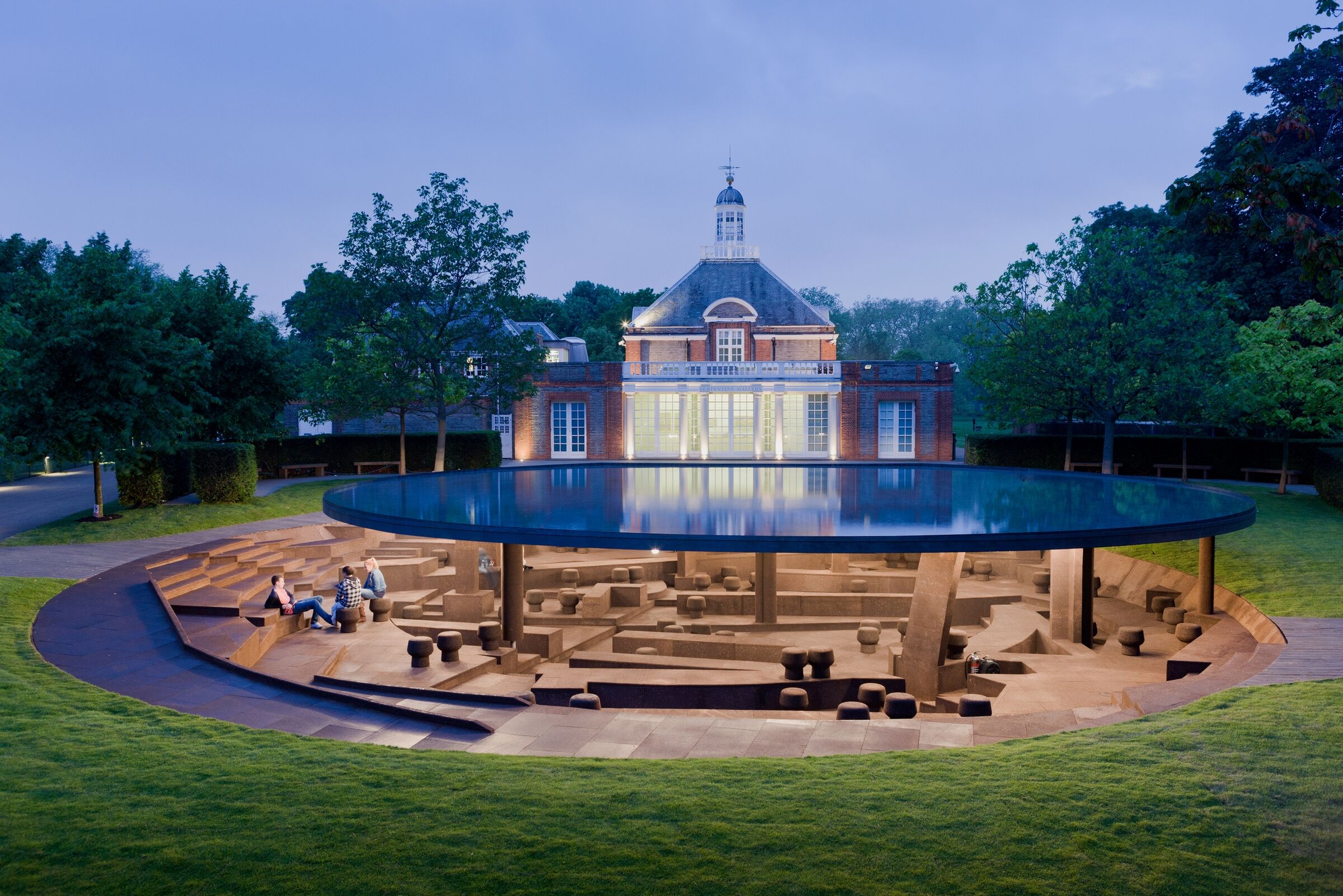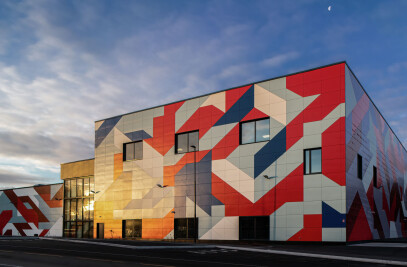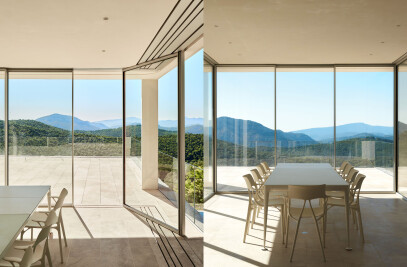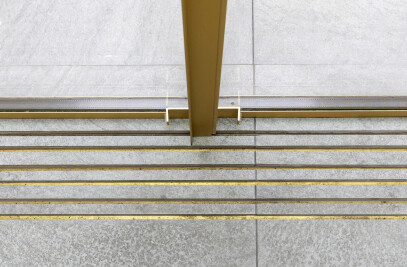Since 2000, Serpentine has given the opportunity for internationally renowned and emerging architects to create their first built structure in England. The aim of the pavilion is to select architects who push the boundaries of contemporary architecture and introduce them to a wider audience.
Architects are asked to design a pavilion that is used as a meeting space and café by day and a forum for learning, debate and entertainment at night. Serpentine collaborates the same way with architects as they do with artists. They aim to realize their vision for a project as close to how they conceived it as possible.
It has become one of those honors, like having an El Croquis or receiving a prestigious award, that puts an architect at the forefront of their profession. Here is an overview of the Serpentine Pavilions counting down to the inaugural Pavilion by Dame Zaha Hadid in 2000.

Serpentine Pavilion 2021 by Sumayya Vally (Counterspace)
By engaging with stories of migration – the dis-placement and re-placement of people – the design symbolically folds London onto the Serpentine lawn to bring together a multitude of histories, referencing diasporas and geographies within and beyond the city. Conversely, during the Summer, fragments of the Pavilion extend into sites across London that bring other voices into conversation. This dissolving of the structure into the city physically and programmatically amplifies multiple centres that have held communities over time.

Serpentine Pavilion 2019 by Junya Ishigami
Ishigami’s design takes inspiration from roofs, the most common architectural feature used around the world. The design of the 2019 Serpentine Pavilion is made by arranging slates to create a single canopy roof that appears to emerge from the ground of the surrounding park. Within, the interior of the Pavilion is an enclosed cave-like space, a refuge for contemplation. For Ishigami, the Pavilion articulates his ‘free space’ philosophy in which he seeks harmony between man-made structures and those that already exist in nature.

Serpentine Pavilion 2018 by Frida Escobedo
The lattice walls of the Pavilion are inspired by a celosia, a traditional breeze wall commonly used in Mexican domestic architecture to bring air and light into the home. Here they are composed of cement roof tiles commonly used in the United Kingdom, arranged into a pattern that diffuses the visitor's view, transforming Kensington Gardens into a blur of greens and blues. The selection of materials, which have a dark colours and textured surface have been chosen for their contrast with these environs.

Serpentine Pavilion 2017 by Kéré Architecture
Taking inspiration from the great tree in his hometown of Gando under which members of the community meet to reflect on the day, Kéré’s design is based on creating this sense of community while connecting people with nature.

Serpentine Pavilion 2016 by BIG - Bjarke Ingels Group
For the Serpentine Pavilion 2016, BIG attempted to design a structure that embodies multiple aspects that are often perceived as opposites: a structure that is free-form yet rigorous, modular yet sculptural, both transparent and opaque, both box and blob.

Serpentine Pavilion 2015 by Selgascano
As a single encompassing concept, Selgascano sought a way to experience architecture through its most common, simple elements: structure, light, transparency, shadows, lightness, form, sensitivity, change, surprise, and one material; Plexiglas.

Serpentine Pavilion 2014 by Smiljan Radić
Externally, the visitor saw a fragile shell suspended on large quarry stones. This shell - white, translucent and made of fibreglass - housed an interior organised around an empty patio, from where the natural setting appeared lower, giving the sensation that the entire volume is floating.

Serpentine Pavilion 2013 by Sou Fujimoto
Occupying some 350 square-metres of lawn in front of the Serpentine Gallery, Sou Fujimoto's delicate, latticed structure of 20mm steel poles will have a lightweight and semi-transparent appearance that will allow it to blend, cloud-like, into the landscape and against the classical backdrop of the Gallery's colonnaded East wing. Designed as a flexible, multi-purpose social space - with a café sited inside - visitors will be encouraged to enter and interact with the Pavilion in different ways throughout its four-month tenure in London's Kensington Gardens.

Serpentine Pavilion 2012 by Herzog & de Meuron and Ai Weiwei
The 2012 Pavilion took visitors beneath the Serpentine's lawn to explore the hidden history of its previous pavilions. Eleven columns characterising each past pavilion and a twelfth column representing the current structure supported a floating platform roof 1.5 metres above ground.

Serpentine Pavilion 2011 by Peter Zumthor
At the heart of Peter Zumthor’s Pavilion was a garden that the architect hoped would inspire visitors to become observers. The design emphasised the role the senses and emotions play in our experience of architecture. With a refined selection of materials Zumthor created contemplative spaces that evoked the spiritual dimension of our physical environment.

Serpentine Pavilion 2010 by Jean Nouvel
Jean Nouvel's design for the Serpentine Gallery Pavilion 2010 contrasted lightweight materials with dramatic metal cantilevered structures, rendered in a vivid red that, in a play of opposites, contrasted with the green of its park setting.

Serpentine Pavilion 2009 by Kazuyo Sejima and Ryue Nishizawa (SANAA)
Describing their structure the architects, Kazuyo Sejima and Ryue Nishizawa, said: "The Pavilion is floating aluminium, drifting freely between the trees like smoke. Its appearance changes according to the weather, allowing it to melt into the surroundings. It works as a field of activity with no walls, allowing uninterrupted view across the park and encouraging access from all sides."

Serpentine Pavilion 2008 by Frank Gehry
Anchored by four massive steel columns, the Pavilion was composed of large timber planks and a complex network of overlapping glass planes that created a dramatic, multi-dimensional space.

Serpentine Pavilion 2007 by Olafur Eliasson & Kjetil Thorsen
Serpentine Gallery’s 2007 Pavilion was a timber-clad structure resembling a spinning top. It brought a dramatic vertical dimension to the more usual single-level Pavilion. A wide spiralling ramp made two complete turns, ascending from the gallery’s lawn to the seating area and continued upwards, culminating at the highest point in a view across Kensington Gardens and down into the chamber below.

Serpentine Pavilion 2006 by Rem Koolhaas
The centrepiece of the design is a spectacular ovoid-shaped inflatable canopy that floats above the Serpentine's lawn. Made from translucent material, the structure is illuminated from within at night. The canopy will be raised into the air or lowered to cover the amphitheatre below according to the weather.

Serpentine Pavilion 2005 by Álvaro Siza and Eduardo Souto de Moura
In designing the Pavilion, Siza sought to 'guarantee that the new building - while presenting a totally different architecture - established a "dialogue" with the neoclassical house'. The result was a structure that mirrored the domestic scale of the Serpentine and articulated the landscape between the two buildings.

Serpentine Pavilion 2004 (unrealised) by MVRDV
MVRDV designed a pavilion that would relate not only to the Serpentine Gallery but also the park itself, by extending both. While previous Serpentine pavilions have been located on the lawn in front of the gallery building, MVRDV's design proposes absorbing the gallery, so as to forge a stronger relationship with the pavilion, and at the same time transform it into a mysterious, hidden space. The pavilion literally extends the existing lawn over the gallery creating an accessible, recreational hill in the park.

Serpentine Pavilion 2003 by Oscar Niemeyer
Built in steel, aluminium, concrete and glass, the Pavilion's ruby-red ramp contrasted with the surprise of a partly submerged auditorium, affording views across the park. It also housed specially conceived wall drawings by Niemeyer.

Serpentine Pavilion 2002 by Toyo Ito
The Serpentine Gallery Pavilion 2002 appeared to be an extremely complex random pattern that proved, upon careful examination, to derive from an algorithm of a cube that expanded as it rotated. The numerous triangles and trapezoids formed by this system of intersecting lines were clad to be either transparent or translucent, giving a sense of infinitely repeated motion.

Serpentine Pavilion 2001 by Daniel Libeskind
Daniel Libeskind's striking design for the Serpentine Gallery Pavilion 2001, entitled Eighteen Turns, was created from sheer metallic planes assembled in a dynamic sequence. Clad in aluminium panels creating brilliant reflections of light, the structure revealed an entirely new perspective of the greenery of the park and the brick building of the gallery.

Serpentine Pavilion 2000 by Zaha Hadid
Zaha Hadid's structure radically reinvented the accepted idea of a tent or a marquee. It took the form of a triangulated roof structure spanning an impressive internal space of 600sq metres by using a steel primary structure. A folding form of angular flat planes extending to the ground gave an illusion of solidity while at the same time creating a variety of internal spaces.


































